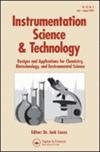Characterization of road surfaces using three near-infrared diode lasers
IF 1.3
4区 工程技术
Q4 CHEMISTRY, ANALYTICAL
引用次数: 0
Abstract
AbstractRapid road network expansion has heightened the importance of surface condition information for traffic accident prevention and route optimization. This article introduces a laser diode-based sensor that identifies seven surface conditions and accurately measure ice, water, and snow film thicknesses on roads. An optical module was developed to detect weak optical signals based on the characteristic absorption spectrum of the target surface. The module used three laser diodes (1310, 1440, and 1550 nm wavelengths) as light sources. Additionally, a road classification algorithm that is adaptable to foggy weather was developed using a multi-wavelength processing protocol. The sensor was subjected to numerous calibration and performance verification experiments. During thick foggy measurements, the processed spectra displayed a maximum variation of 2.372% across a 600 to 25,000 m visibility range with a relative standard deviation of only 0.328%. This demonstrated effective weakening of the effects of visibility variations. During winter field testing, the sensor classified road conditions effectively and accurately measured ice, snow, and water film thicknesses, with a correlation coefficient of 0.97444. The accuracy of the measurements was less than 0.5 mm. The sensor’s effectiveness for long-term field-based road testing has been verified.Keywords: Diode laserinfrared spectrometrymulti-wavelength processingoptical sensorroad surface condition AcknowledgmentWe thank David MacDonald, MSc, from Liwen Bianji (Edanz) (www.liwenbianji.cn/) for editing the English text of a draft of this manuscript.Disclosure statementNo potential conflict of interest was reported by the authors.Additional informationFundingThis work was supported by the Key Research and Development Projects in Anhui Province, China under Grant 1908085MD114.使用三个近红外二极管激光器表征路面
摘要:随着道路网络的不断扩大,路面状况信息对交通事故预防和路线优化的重要性日益凸显。本文介绍了一种基于激光二极管的传感器,它可以识别七种表面状况,并准确测量道路上的冰、水和雪膜厚度。研制了一种基于目标表面特征吸收光谱的微弱光信号检测模块。该模块使用三个激光二极管(波长为1310、1440和1550纳米)作为光源。此外,采用多波长处理协议,开发了一种适用于大雾天气的道路分类算法。该传感器进行了多次校准和性能验证实验。在浓雾测量中,处理后的光谱在600 ~ 25,000 m的能见度范围内显示出2.372%的最大变化,相对标准偏差仅为0.328%。这表明能见度变化的影响有效减弱。在冬季现场测试中,该传感器对路况进行了有效分类,准确测量了冰、雪、水膜厚度,相关系数为0.97444。测量精度小于0.5 mm。该传感器在长期现场道路测试中的有效性已得到验证。关键词:二极管激光红外光谱多波长处理光学传感器路面状况感谢Liwen Bianji (Edanz) (www.liwenbianji.cn/)的David MacDonald硕士编辑了本文草稿的英文文本。披露声明作者未报告潜在的利益冲突。本研究得到安徽省重点研发项目资助(基金号:1908085MD114)。
本文章由计算机程序翻译,如有差异,请以英文原文为准。
求助全文
约1分钟内获得全文
求助全文
来源期刊

Instrumentation Science & Technology
工程技术-分析化学
CiteScore
3.50
自引率
0.00%
发文量
45
审稿时长
>12 weeks
期刊介绍:
Instrumentation Science & Technology is an internationally acclaimed forum for fast publication of critical, peer reviewed manuscripts dealing with innovative instrument design and applications in chemistry, physics biotechnology and environmental science. Particular attention is given to state-of-the-art developments and their rapid communication to the scientific community.
Emphasis is on modern instrumental concepts, though not exclusively, including detectors, sensors, data acquisition and processing, instrument control, chromatography, electrochemistry, spectroscopy of all types, electrophoresis, radiometry, relaxation methods, thermal analysis, physical property measurements, surface physics, membrane technology, microcomputer design, chip-based processes, and more.
Readership includes everyone who uses instrumental techniques to conduct their research and development. They are chemists (organic, inorganic, physical, analytical, nuclear, quality control) biochemists, biotechnologists, engineers, and physicists in all of the instrumental disciplines mentioned above, in both the laboratory and chemical production environments. The journal is an important resource of instrument design and applications data.
 求助内容:
求助内容: 应助结果提醒方式:
应助结果提醒方式:


